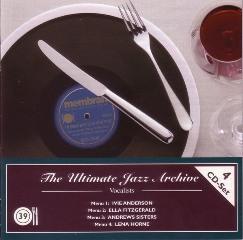The Ultimate Jazz Archive Vol.156 - Lena Horne [1936-1944] [2005]
The Ultimate Jazz Archive Vol.156 - Lena Horne [1936-1944] [2005]

01.That’s What Love Did To Me 02.You’re My Thrill 03.Good-For-Nothin’ Joe 04.Haunted Town 05.The Captain And His Men 06.St. Louis Blues 07.Careless Love 08.Aunt Hagar’s Blues 09.Beale Street Blues 10.Love Me A Little Little 11.Don’t Take Your Love From Me 12.Out Of Nowhere 13.Prisoner Of Love 14.As Long As I Live 15.I’ll Wind 16.Stormy Weather 17.The Man I Love 18.Where Or When 19.Mad About The Boy 20.I Gotta Right To Sing The Blues 21.Moanin’ Low 22.One For My Baby 23.I Didn’t Know About You
Lena Calhoun Horne was born June 30, 1917, in Brooklyn, New York. In her biography she stated that on the day she was born, her father was in the midst of a card game trying to get money to pay the hospital costs. Her parents divorced while she was still a toddler. Her mother left later in order to find work as an actress and Lena was left in the care of her grandparents. When she was seven her mother returned and the two traveled around the state, which meant that Lena was enrolled in numerous schools (for a time she also attended schools in Florida, Georgia and Ohio). Later she returned to Brooklyn. She quit school when she was 14 and got her first stage job at 16, dancing and later singing at the famed Cotton Club in Harlem (a renowned theater in which black performers played before white audiences. It was immortalized in Cotton Club (1984)). She was in good hands at the club, especially when people such as Cab Calloway and Duke Ellington took her under their wings and helped her over the rough spots. Before long her talent resulted in her playing before packed houses. If she had never made a movie, her music career would have been enough to have ensured her legendary status in the entertainment industry, but films were icing on the cake. After she made an appearances on Broadway, Hollywood came calling. At 21 years of age Lena made her first film, The Duke Is Tops (1938). It would be four more years before she appeared in another, Panama Hattie (1942), playing a singer in a nightclub.
By now Lena had signed with MGM but, unfortunately for her, the pictures were shot so that her scenes could be cut out when they were shown in the South, since most theaters in the South refused to show films that portrayed blacks in anything other than subservient roles to whites, and most movie studios did not want to take a chance on losing that particular source of revenue. Lena did not want to appear in those kinds of stereotyped roles (and who could blame her?). In 1943 MGM loaned her to 20th Century-Fox to play the role of Selina Rogers in the all-black musical Stormy Weather (1943), which did extremely well at the box-office. Her rendition of the title song became a major hit on the musical charts. In 1943 she appeared in Chatka w niebie (1943), regarded by many as one of the finest performances of her career. She played Georgia Brown opposite Ethel Waters and Eddie 'Rochester' Anderson in the all-black production. Rumors were rampant that she and Waters just did not get along well, although there was never any mention of the source of the alleged friction. That was not the only feud on that picture, however. Other cast members sniped at one another and it was a wonder the film was made at all. Regardless of the hostilities, the movie was released to very good reviews from the ever tough critics. It went a long way in showing the depth of the talent that existed among black performers in Hollywood, especially Lena. Lena's musical career flourished, but her movie career stagnated. Minor roles in films such as Boogie-Woogie Dream (1944), Words and Music (1948) and Mantan Messes Up (1946) did little to advance her film career, due mainly to the ingrained racist attitudes of the time (aven at the height of Lena's musical career, she was often denied rooms at the very hotels in which she performed, because they would not let blacks stay there).
After Meet Me in Las Vegas (1956), Lena left films to concentrate on music and the stage. She returned in 1969, as Claire Quintana in Death of a Gunfighter (1969). Nine years later she returned to the screen again in the all-black musical Czarnoksieznik (1978), where she played Glinda the Good Witch. Although that was her last big-screen appearance, she stayed busy in television, appearing in A Century of Women (1994) and That's Entertainment! III (1994).
Had it not been for the prevailing racial attitudes during the time when Lena was just starting her career, it's fair to say that it would have been much bigger, and come much sooner, than it was. Even taking those factors into account, Lena Horne is still one of the most respected, talented and beautiful performers of all time--and she's still singing! ---Denny Jackson, imdb.com
download: uploaded yandex 4shared mediafire solidfiles mega filecloudio nornar ziddu








